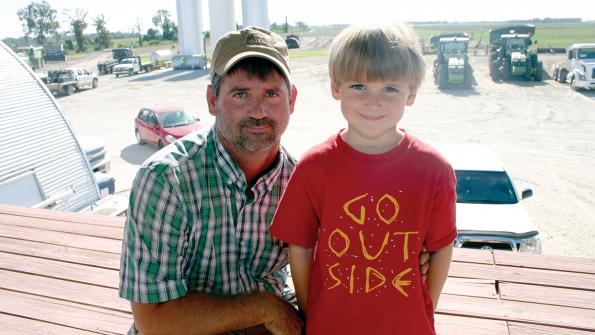
Outside Mike and Mikey Taylor’s office window, the large gravel lot is full of harvest-season activity. Wind carries away pale dust that’s being kicked up by a steady stream of combines and trucks.
Mikey Taylor, fresh out of the field, tips his ballcap back and smiles. Taylor is the latest Arkansas producer to harvest 100-bushel soybeans – 101.319 bushels per acre, to be exact. And it’s certainly worth noting he did it with a dicamba-tolerant variety.
“We planted Asgrow 47X6 on April 9 no-till into a cover crop. We had a plant population of 145,000 and ended up with 130,000 on 30-inch rows.”
IT’S FREE! Stay informed on what’s happening in Mid-South agriculture: Subscribe to Delta Farm Press Daily.
The field -- a silt loam cotton soil -- is southwest of Helena in Phillips County. It was rotated from corn.
“The cover crop was cereal rye, radish and black oats. We use cover crops a lot to help build organic matter, to minimize erosion and help improve the soil’s health. It works and we’ve been doing it for around 20 years.”
Subsoil no more
The Taylors used to subsoil every acre. Today, “that subsoiler is sitting across from the old John Deere dealership waiting for a buyer. It’s pointless to keep it around – we use cover crops. We’ve actually got an air-seeder in (the contest) field right now planting a cover crop.”
“I think the last time we did subsoiling of any substantial acreage was about six years ago,” Mike says. “We used to subsoil so much the killdeers were complaining.”
Mikey did do a bit of fieldwork on the contest field this year. “The field had some old beds in it. I knocked those down flat. They were old and I was worried if we went back to corn I wouldn’t have a good row to bed on. And if you want to go true no-till, you can’t have the beds. So, I’m going to plant flat and run a water furrow plow that makes just a small streak. Every other middle will be watered.”
Contest
The contest field had and application of Boundary and Gramoxone behind the planter. “We came back with a quart of Prefix and a quart of Touchdown,” says Mikey. “Then we did the lay-by and furrow irrigated. For a fungicide, we put out Quadris SBX.”
The beans came up “very well, grew off good. There really wasn’t much we did different to the field compared to others on the farm. Everything worked out well for us until June, when it turned off dry and we needed to irrigate. Then, in July, it turned off very wet. We had one rain about August 10. All told, we furrow irrigated three times.”
Mikey laughs and says there wasn’t a lot of deliberation over the best place to choose for the contest plot. “I was on the combine cutting and just picked out a spot in the field that looked good for the yield contest.”
The contest beans were harvested September 15 at 12.4 percent moisture. “That’s dry, man. Farmer’s Supply verified the official count.”
Friends
Mikey says takes in going over the 100-bushel barrier is shared among farming friends. “There’s a handful of good, old boys that just enjoy competing a little bit, seeing whose yield comes out top. It’s harmless but makes it fun, talking trash a little bit. No doubt one of them will be next to do it.
“We’ve been part of the contest for as long as it’s been going, I think. It really is fun to give it a shot. I wish they still had a dryland component, though.”
The county average is 50 bushels, says Robert Goodson, county Extension agent. “It takes a good farmer to grow 100-bushel beans. It doesn’t happen just because. It takes someone who is willing to expend the effort, has the knowledge, the know-how and willingness to grow better crops.
“That’s why the group of farmers growing 100 bushels, or close to it … are determined to make an economic living out of farming. If it takes growing 80- or 90-bushel beans, so be it. Someone growing 15 or 20 bushels can’t make it anymore.”
It was inevitable someone in the area “would bust 100 bushels,” says Goodson. “Mikey had already cut 96 bushels, or close, and others have almost done it. Guys cutting in the mid-90s aren’t that hard to find. It’s just finding the right field to cut.”
Goodson was surprised when it was Taylor’s field that did the trick. “Mikey’s field didn’t look all that impressive to me. I thought they might go 90 bushels. But the plants just didn’t look big enough, tall enough, to produce 100-bushel beans. That tells you I can’t eyeball beans and tell you much yield-wise.”
The Taylors, looking for help with a terrible resistant-pigweed problem, actually grew several hundred acres of dicamba-tolerant beans this year. “We just wanted to see the yield potential of the dicamba varieties,” says Mikey. “Besides the 47X6, we also planted Asgrow 44X6. Both did very well, but the 44s were all dryland. I want to be very clear: no dicamba was applied to the beans.
“If you look at Asgrow plots – and we plant variety plots for their research – every bean in them is a (dicamba-tolerant) variety. That’s where the industry is pointing so we figured ‘why not go ahead see what they’ll do here?’
Next year, Mikey expects to be “more aggressive planting dicamba beans. If the state approves (new dicamba formulations for use), I’ll probably be 90 to 100 percent dicamba beans.”
One tip: Taylor salted the dicamba-tolerant beans before cutting. “One thing that’s kind of interesting about these varieties is some of the guys who didn’t salt had problems. They really want to stay green.”
About the Author(s)
You May Also Like




